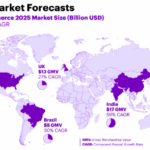Online shopping has become a part of everyday life for people in the Nordic countries. According to the latest E-commerce in the Nordics Spring 2025 report by PostNord International, 83% of consumers in Sweden, Finland, Norway, and Denmark said they had made an online purchase in the past 30 days. This shows a small but steady increase from last year’s 82%.
The report is based on a survey conducted in February and March 2025. It included 1,000 respondents aged 18 to 79 from across the four countries. The findings give a clear picture: people in the Nordics are not only shopping online regularly, but they are also looking beyond their national borders when doing so.
In fact, 73% of consumers said they had made at least one online purchase from another country in the past 12 months. This trend of cross-border shopping is becoming more common, likely due to a combination of competitive pricing, wider product selection, and better international delivery options.
Another interesting trend noted in the report is the rise in second-hand purchases. In the last month alone, 32% of Nordic consumers bought used items online. This shows a growing interest in sustainable shopping, as well as in saving money.
At DMSMatrix, we believe these insights are especially important for ecommerce businesses aiming to reach customers in the Nordic region. Whether you’re a local seller or an international brand, knowing that Nordic shoppers are comfortable buying across borders opens up more opportunities to connect with them.
Cross-border logistics, multi-language support, clear return policies, and trustworthy shipping options will continue to play a key role in meeting the expectations of Nordic consumers. With more shoppers now used to buying from outside their country, companies that offer a seamless and reliable experience will have a clear advantage.
This report also reminds us that ecommerce in the Nordics is not just about convenience. It reflects changing habits, economic factors, and values such as sustainability. As we continue to support clients expanding into new markets, data like this helps shape practical strategies—grounded in what real people are doing, not just market predictions.










